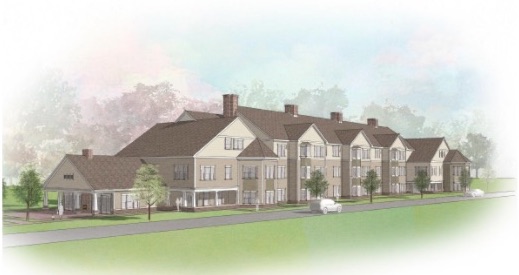MONROE, CT — Connecticut Housing Partners’ proposal to construct 49-units of senior housing on Main Street under the state’s affordable housing statute was well received during a Planning and Zoning Commission hearing Thursday.
Connecticut Housing Partners has been developing, owning and managing affordable housing throughout the state for 31 years. It currently has over 1,000 residents living at its 15 properties.
David S. Hoopes, an attorney for CHP, touted the plan to build a three-story New England style building for residents age-62-and-older on Main Street in Monroe as an attractive and well designed project on a site naturally buffered from neighborhood impacts.
“We think it’s the kind of project that, even if this wasn’t a 8-30g application, would be favorably viewed by this commission and that it’s something that’s going to benefit Monroe, especially its senior citizens,” Hoopes said, “and that it’s something that, when all’s said and done, we’re pretty confident everybody could be proud of.”
The housing would be built on just over two acres at 195, 201 and 211 Main Street, close to where Skate Time roller rink used to be.
The plan is broken down into three applications before the Planning and Zoning Commission, one to establish a new Elderly Affordable Housing District, another to rezone the property from a Business District (B2) to the new district and one for the site plan.
Mutual Housing Association of Southwestern Connecticut Inc., doing business as CHP, filed the applications.
On Thursday, Planning and Zoning Commission Chairman Michael O’Reilly kept the hearing open, pending wetlands approval. The commission’s next meeting is Feb. 4.
Among CHP’s housing is Huntington Place, 1235 Huntington Turnpike in Trumbull; Wilton Commons, 21 Station Road in Wilton; and Greenfield Commons, 580 Villa Ave. in Fairfield.
Town Planner Rick Schultz told the commission he called various communities where CHP has housing and that all of them are proud of what CHP built.
“It worked quite nicely, because it coincided with our POCD update,” Schultz said of the Monroe proposal.
He said the town’s consultant for its Plan of Conservation and Development update is aware of the plan and it will be incorporated as a site for elderly affordable housing.
Schultz said it will also be included in the affordable housing plan Monroe must create after the POCD update, adding Connecticut will require all municipalities to have an affordable housing plan by 2022.
Working together
A town can only oppose an 8-30g affordable housing application if it poses a threat to public health and safety. Schultz said applications denied at the local level usually end up being approved by the courts, resulting in a development that falls short of the architectural expectations of the community.
Town land use staff worked closely with Connecticut Housing Partners early on in the process in an effort to come up with a project that’s best suited for Monroe.
“This attractive multi-story building will fit on this property as discussed by the project consultants, staff has always worked with the goal in mind that we need the applicant to enact reasonable zoning standards,” Schultz said.
Hoopes said CHP incorporated all of the input from town staff into its plan.
Schultz said the Architectural Review Board found the overall architecture to be consistent with traditional design and understood the need to increase the 2.5 story town limit to three stories for the site to achieve its development goals.
A traditional appearance
David Goslin, an architect from Crosskey Architects in Hartford, showed a rendering for the 50,000-square-foot facility.
“It’s a very traditional looking building in keeping with the architecture of Monroe,” he said. “Knowing it is a three story building, we designed the ends of the building to kind of step down.”
The independent living facility’s front facade has bay windows and gables, according to the design. The building has a stone veneer base, traditional clapboard siding, chimneys and an architectural asphalt shingle roof.
The siding would be made with HardiPlank, a material that is noncombustible and does not rot, according to Goslin. Colors of the siding would be Navaho Beige on third level and in the gables and Taupe on the lower level. Goslin said the trim would be white.
The mechanicals would be on a flat section of roof in the back, hidden from public view.
The average unit size is 695 square feet.
“The individual units are pretty much all the same,” Goslin said. “There is an open living/dining space adjacent to the galley kitchen, which has a little breakfast nook and counter space. The other half of the unit has a decent size bedroom, a closet and handicapped accessible bathroom.”
Goslin said there would be 15 units on the first floor, 18 on second and 16 on the third.
The main entrance would be on the south end of the first floor, leading to a lobby with a management office that would be open during the day. To the left of the lobby, a community room would serve as a gathering place for tenants to have social events.
Goslin said it would open up to a covered porch and patio to the south end, between the building and the 59-space parking lot.
Off the community room, a small kitchen and activity room would host small functions for tenants and be used to cater larger events in the community room.
The first floor would also have a nurse’s office and a hair salon, which would only be open as an amenity for tenants. There would also be a chapel and media room and a common laundry area.
There would be elevators in the lobby and on the far north end of the building for secondary access.
Drainage, traffic
Emily Weckman, a landscape architect for TO Design in New Britain, led the presentations on lighting, signage, plantings and the drainage system, which she said is designed to accommodate a 100-year-storm and have no impact on the wetlands.
David Bjorklund, president of Spath-Bjorklund Associates Inc. in Monroe, designed the site storm drainage and the septic system.
“We’re picking up all the drainage in the catch basins in the parking lot and driveway to the building,” he said.
Bjorklund said the proposal is to store all the water and runoff under the parking lot in a series of galleys to the south of the proposed building, adding the storm drainage, detention and water quality elements meet requirements of the town, the Connecticut Department of Transportation, and the Connecticut Department of Energy and Environmental Protection.
The system would ultimately flow into a catch basin in the green area at Old Main Street and Main Street, to the east side of Route 25, then to an existing pipe that discharges into a wooded area between the car wash and Sippin Energy, according to Bjorklund.
He said the septic system would be under the parking lot on the south end of the site. It would handle of a flow of over 2,000 gallons a day, so approval from the Connecticut Department of Public Health would also be needed, Bjorklund said.
Joe Balkus, the traffic engineer for the project, said the housing would be a “very low traffic generator,” with 20 vehicles per day during peak hours.
He said the housing would be along a straight stretch of Route 25, offering sightlines of over 600 feet at its driveway, adding that exceeds the DOT requirement of 425 feet.
Balkus said there were four crashes to the south and two to the north, calling it “a very low crash history.”
The DOT asked the developers to remove the north access to the property and have a new driveway into the site, because the DOT uses the old access drive while plowing the state roadway.
“The proposed development with this site access, as shown, will not have a significant impact on traffic operations along Route 25,” Balkus said.
Weckman said a sidewalk would be built in front of the property, along Main Street.
‘A beautiful plan’
O’Reilly asked commission members if they wanted to comment on the application.
“I agree with Rick. I think that this is a beautiful plan,” Nicole Lupo said, referring to the town planner’s previous comments. “It’s right in line with our POCD mission and goals. I think it fills a great need in our town for our aging population and our ability to keep them here.”
Lupo asked if there could be changes to allow people age 55-and-older who have a disability to rent a unit. But Steve Gulick, vice president of real estate for CHP, said one of their funding sources has guidelines requiring an age restriction of 62-and-older.
Lupo asked about safety in emergencies and Goslin said the building would be fully sprinklered with a backup diesel generator in the event of a power outage.
Lupo also asked if any units would be designed for residents who are handicapped.
Connecticut code requires that 10 of the units be fully handicapped accessible, according to Goslin. He said the remaining 39 units are “type B units,” which are handicapped adaptable. All that is needed to convert those units is to add grab bars in the bathroom, he said.
Leon Ambrosey, another commissioner, asked whether the reserve septic system has adequate capacity should the main one fail. Bjorklund said it does.
When the hearing was opened to comments from members of the public, Ronald Bunovsky Sr. noted how there is a high percentage of failures for community septic systems in Monroe, despite those systems being designed according to the same requirements.
Ray Giovanni, who serves as chairman of the Economic Development Commission and president of the Monroe Chamber of Commerce in town, said, “I had the privilege of seeing a facility like this in lower Fairfield County. What I observed there was a great facility.”
Giovanni spoke of the vitality of the residents and how well they interacted with staff, adding many of the rooms he visited had one tenant, so it is not necessarily all couples.
“Since moving here in 1993, we’ve spoken for decades of how we’re losing seniors in this town, because they can’t afford it living on a fixed income,” Giovanni said. “I applaud the efforts of this group for trying to amend some of our rules into their plan.”






Affordable housing that’s good if the price for a one bedroom is truly affordable say starting at $1250 monthly or less. I would like to an apartment.
The architectural drawings looks great. Please let me hear from you.
Your architectural drawings looks great and I would like a one bedroom affordable apartment.
Send application I definitely interested
Presently living in Woodstock, Ga. after living in Ffld and Monroe for 65 years. Interested in returning to Ct. to be with family. Thank you.
Looking for prices
Hi Mary, the housing is not built yet. Connecticut Housing Partners is working to secure funding for construction. For more information, call Connecticut Housing Parters at (203) 359-6940.